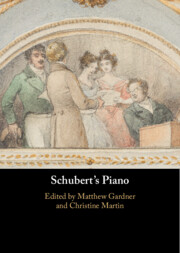Book contents
- Schubert’s Piano
- Schubert’s Piano
- Copyright page
- Contents
- Figures
- Tables
- Music Examples
- Notes on Contributors
- Acknowledgements
- Abbreviations and Conventions
- Introduction
- Part I The Piano in Schubert’s World
- Part II Instruments and Performance
- 5 Schubert and the Viennese Piano
- 6 Performing Simultaneous Triplets and Dotted Rhythms in Schubert’s Piano Music
- 7 Viennese Pianoforte Treatises as a Reflection of Schubert’s Pianistic Audience
- Part III Sound and Musical Imagery
- Part IV Understanding Schubert’s Writing for the Piano
- Select Bibliography
- Index
5 - Schubert and the Viennese Piano
from Part II - Instruments and Performance
Published online by Cambridge University Press: 31 August 2024
- Schubert’s Piano
- Schubert’s Piano
- Copyright page
- Contents
- Figures
- Tables
- Music Examples
- Notes on Contributors
- Acknowledgements
- Abbreviations and Conventions
- Introduction
- Part I The Piano in Schubert’s World
- Part II Instruments and Performance
- 5 Schubert and the Viennese Piano
- 6 Performing Simultaneous Triplets and Dotted Rhythms in Schubert’s Piano Music
- 7 Viennese Pianoforte Treatises as a Reflection of Schubert’s Pianistic Audience
- Part III Sound and Musical Imagery
- Part IV Understanding Schubert’s Writing for the Piano
- Select Bibliography
- Index
Summary
There can be little doubt that the piano was one of Schubert’s instruments of choice, featuring not only in an array of solo pieces but also in chamber music and as an accompaniment to Lieder. Given the popularity of the instrument in Vienna during the early nineteenth century, this is perhaps not surprising. However, very little is known about Schubert’s own instruments, or which specific makers and models he preferred throughout his career. The instruments themselves underwent substantial change during Schubert’s lifetime, with preference moving away from the delicate touch and tone of late eighteenth-century models to the larger compass and more weighty tonal qualities of the instruments of the 1820s and 1830s, in part as a reaction to the demands of composers. By considering Schubert’s connection to specific instrument makers, the unique qualities of Viennese instruments and individual works for pianoforte by Schubert, this paper revisits what is known about the instruments he may have preferred, while also making observations about the connections between his keyboard music and the instruments that were available in early nineteenth-century Vienna.
- Type
- Chapter
- Information
- Schubert's Piano , pp. 93 - 115Publisher: Cambridge University PressPrint publication year: 2024

